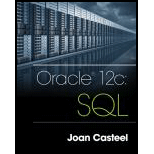Solutions for Oracle 12c: SQL
Problem 3RQ:
What is the purpose of the SELECT statement?
Problem 5RQ:
What is the purpose of a column alias?Problem 7RQ:
When is it appropriate to use a column alias?
Problem 10RQ:
What is a NULL value?
Problem 1MC:
Which of the following SELECT statements displays a list of customer names from the CUSTOMERS...Problem 2MC:
Which clause is required in a SELECT statement?
WHERE
ORDER BY
GROUP BY
FROM
all of the above
Problem 3MC:
Which of the following is not a valid SELECT statement?
SELECT lastname, firstname FROM...Problem 7MC:
Which of the following is a valid SELECT statement? a. SELECT TITLES TITLE! FROM BOOKS; b. SELECT...Problem 8MC:
Which of the following symbols is used in a SELECT clause to display all columns from a...Problem 10MC:
When must a comma be used in the SELECT clause of a query? a. when a field name is followed by a...Problem 12MC:
Which clause is not required in a SELECT statement?
SELECT
FROM
WHERE
All of the above clauses are...Problem 13MC:
Which of the following lines of the SELECT statement contains an error? 1 SELECT title, isbn, 2...Problem 14MC:
Which of the following lines of the SELECT statement contains an error? 1 SELECT ISBN, 2 retail-cost...Problem 15MC:
Which of the following lines of the SELECT statement contains an error? 1 SELECT title, cost, 2...Problem 16MC:
Which of the following lines of the SELECT statement contains an error?
1 SELECT name, contact,
2...Problem 17MC:
Which of the following lines of the SELECT statement contains an error?
1 SELECT ISBN, || 'is the...Problem 18MC:
Which of the following lines of the SELECT statement contains an error?
1 SELECT title, category
2...Problem 19MC:
Which of the following lines of the SELECT statement contains an error? 1 SELECT name, contact 2...Problem 20MC:
Which of the following lines of the SELECT statement contains an error?
1 SELECT *
2 FROM...Browse All Chapters of This Textbook
Chapter 1 - Overview Of Database ConceptsChapter 2 - Basic Sql Select StatementsChapter 3 - Table Creation And ManagementChapter 4 - ConstraintsChapter 5 - Data Manipulation And Transaction ControlChapter 6 - Additional Database ObjectsChapter 7 - User Creation And ManagementChapter 8 - Restricting Rows And Sorting DataChapter 9 - Joining Data From Multiple TablesChapter 10 - Selected Single-row Functions
Book Details
Now you can master the latest version of the fundamental SQL language used in all relational databases today with ORACLE 12C: SQL, 3E. Much more than a study guide, this edition helps you transform a basic knowledge of databases into proficiency with the latest SQL and Oracle concepts and techniques. You learn to use Oracle 12c SQL most effectively as you prepare for the first exam in the Oracle Database Administrator or Oracle Developer Certification Exam paths. This edition initially focuses on creating database objects, including tables, constraints, indexes, sequences, manipulating data, and more. The author then explores both basic data query techniques as well as advanced query topics using a proven hands-on approach. ORACLE 12C: SQL, 3E introduces the latest features and enhancements in 12c, from enhanced data types and invisible columns to new CROSS and OUTER APPLY methods for joins. To help you transition to further studies and even more advanced books in this series, appendixes introduce SQL tuning, compare Oracle's SQL syntax with other databases, and overview Oracle connection interface tools: SQL Developer and SQL Plus. Trust ORACLE 12C: SQL, 3E to provide the knowledge you need for Oracle certification testing and the solid foundation for pursuing a career as a database administrator or developer.
Sample Solutions for this Textbook
We offer sample solutions for Oracle 12c: SQL homework problems. See examples below:
Purpose of an E-R model: Entity-Relationship Model (ERM) is used as a high-level logical data model...Data dictionary: Data dictionary is referred as the components of Database Management System (DBMS)...Chapter 3, Problem 1RQChapter 4, Problem 1RQChapter 5, Problem 1RQ“WHERE” clause: The “WHERE” clause is used to limit the number of rows. The “WHERE” clause is used...Chapter 10, Problem 1RQ
More Editions of This Book
Corresponding editions of this textbook are also available below:
Oracle 10g: SQL
1st Edition
ISBN: 9781418836290
EBK ORACLE 12C: SQL
3rd Edition
ISBN: 9781305465305
Bundle: Oracle 12c: SQL, 3rd + SAM 365/2016 Assessment, Training and Projects v1.0 Single-Term Printed Access Card
3rd Edition
ISBN: 9781337575058
EBK ORACLE 12C: SQL
3rd Edition
ISBN: 8220101292070
ORACLE 12C: SQL
17th Edition
ISBN: 9781305449947
Related Computer Science Textbooks with Solutions
Still sussing out bartleby
Check out a sample textbook solution.
